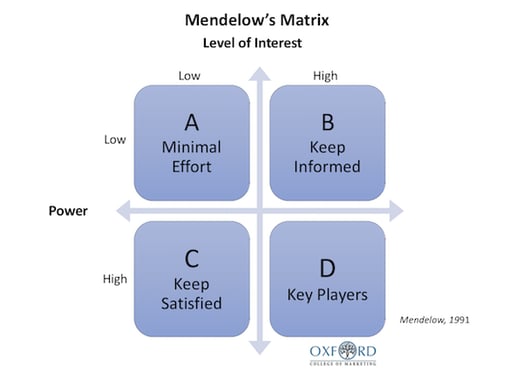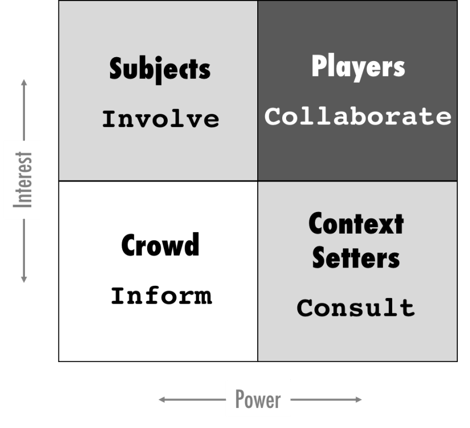The greatest obstacle that every Business Analyst/Project Manager comes across is handling of the stakeholders. Management of stakeholders is critical for every project. Stakeholder may refer to anyone who is involved in the project. They may be involved directly or indirectly and can be classified into 2 types namely Internal and External

Mapping Your Stakeholders Early On
You might find it very useful to analyse all stakeholders that would impact your business strategy, marketing communications campaigns or new product launches at the start of your project. By creating a Mendelow’s Matrix you can easily identify your priority stakeholder audiences and therefore work out a plan to manage communications while keeping all groups satisfied. Equally, when planning a communications campaign, you can analyse stakeholder audiences to be targeted using this tool.
Power Interest Grid:
- Knowledge Area: Business Analysis Planning & Monitoring
- Applicable Task: Conduct Stakeholder Analysis
- Useful When: Identifying stakeholder power, attitudes and interests in the project. Stakeholders are extremely dynamic and may move all over the matrix when their interest/power changes.
- The Power Interest Grid, which is also known as the Power Interest Matrix, is a simple tool that helps you categorize project stakeholders with increasing power and interest in the project.
- This tool helps you focus on the key stakeholders who can make or break your project.
- It was Medlow’s idea which suggests “we analyse our stakeholder groups based on Power(the ability to influence our organisation strategy or project resources) and Interest (how interested they are in the organisation or project succeeding)”

So how does Power Interest Grid work?
So let us note all the stakeholders that are involved in the project and classify them into four types
- PLAYERS: High Interest and High Power
- SUBJECTS: High Interest and Low Power
- CONTEXT SETTERS: Low Interest and High Power
- CROWD: Low Interest and Low Power
PLAYERS:
These are the people who play a major role and hence must be collaborated in almost every aspect. Establish a close and trustful relationship with them. The Players in the project may be Project Manager, Product Owner and Development Team.
SUBJECTS:
They are great allies who help us in securing knowledge and understanding of the project.Help them involved on a regular basis as they are a useful asset.Eg: Users
CONTEXT SETTERS:
The Context setters are those who have a low interest but great power in the project Eg: Senior Executives and Management.These individuals drive the project and must listen to their voice.Have meetings with them to hear their ideas and concerns.
CROWD:
These individuals will require some ongoing communication about the project’s progress but probably the least of all stakeholders.An example of a crowd is HR

TO SUMMARISE:
|
STAKEHOLDER GROUP |
ENGAGEMENT |
FREQUENCY |
SAMPLE TECHNIQUES |
|
Players |
Collaborate |
Once per Sprint |
Collaborative workshops including strategy and roadmap workshops, sprint review meetings |
|
Subjects |
Involve |
Monthly |
Sprint review meetings |
|
Context Setters |
Consult |
Quarterly |
One-on-one meetings |
|
Crowds |
Inform |
Quarterly |
Newsletters |
Further Learning and Reference:
- https://pure.ulster.ac.uk/en/publications/stakeholder-management-and-sport-facilities-a-case-study-of-the-e-3
- https://blog.oxfordcollegeofmarketing.com/2018/04/23/what-is-mendelows-matrix-and-how-is-it-useful/
- https://www.romanpichler.com/blog/stakeholder-engagement-analysis-power-interest-grid/#:~:text=A%20common%20stakeholder%20analysis%20technique,their%20power%20and%20their%20interest.
- https://businessanalystlearnings.com/ba-techniques/2013/1/23/how-to-draw-a-stakeholder-matrix
- https://www.researchgate.net/figure/Stakeholder-power-interest-grid-Source-adapted-from-Ackermann-Eden-2011-p183_fig1_282848702#:~:text=interest%20for%20them.-,3.,something%20changes%20their%20interest%20level.
- https://www.productplan.com/glossary/stakeholder-analysis/









